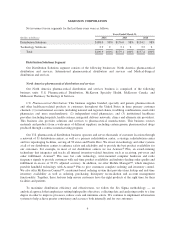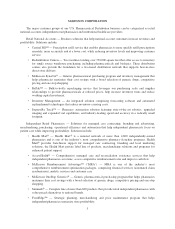McKesson 2016 Annual Report Download - page 20
Download and view the complete annual report
Please find page 20 of the 2016 McKesson annual report below. You can navigate through the pages in the report by either clicking on the pages listed below, or by using the keyword search tool below to find specific information within the annual report.McKESSON CORPORATION
generic products, the brand-name company could assert infringement claims against us. While we generally
obtain indemnification against such claims from generic manufacturers as a condition of distributing their
products, there can be no assurances that these rights will be adequate or sufficient to protect us.
The healthcare industry is highly regulated, and further regulation of our distribution businesses and
technology products and services could impose increased costs, negatively impact our profit margins and the
profit margins of our customers, delay the introduction or implementation of our new products, or otherwise
negatively impact our business and expose the Company to litigation and regulatory investigations.
Healthcare Fraud: We are subject to extensive and frequently changing local, state and federal laws and
regulations relating to healthcare fraud, waste and abuse. Local, state and federal governments continue to
strengthen their position and scrutiny over practices involving fraud, waste and abuse affecting Medicare,
Medicaid and other government healthcare programs. Our relationships with pharmaceutical and medical-
surgical product manufacturers and healthcare providers, as well as our provision of products and services to
government entities, subject our business to laws and regulations on fraud and abuse, which among other things:
(1) prohibit persons from soliciting, offering, receiving or paying any remuneration in order to induce the referral
of a patient for treatment or to induce the ordering or purchasing of items or services that are in any way paid for
by Medicare, Medicaid or other government-sponsored healthcare programs; (2) impose a number of restrictions
upon referring physicians and providers of designated health services under Medicare and Medicaid programs;
and (3) prohibit the knowing submission of a false or fraudulent claim for payment to, and knowing retention of
an overpayment by, a federal healthcare program such as Medicare and Medicaid. Many of the regulations
applicable to us, including those relating to marketing incentives, are vague or indefinite and have not been
interpreted by the courts. The regulations may be interpreted or applied by a prosecutorial, regulatory, or judicial
authority in a manner that could require us to make changes in our operations. If we fail to comply with
applicable laws and regulations, we could become liable for damages and suffer civil and criminal penalties,
including the loss of licenses or our ability to participate in Medicare, Medicaid and other federal and state
healthcare programs.
Reimbursements: Both our profit margins and the profit margins of our customers may be adversely affected
by laws and regulations reducing reimbursement rates for pharmaceuticals, medical treatments and related
services, or changing the methodology by which reimbursement levels are determined. For example, the Patient
Protection and Affordable Care Act and the Health Care and Education Reconciliation Act (collectively the
“Affordable Care Act”), signed into law in 2010, revised, subject to rulemaking, the federal upper limits (“FUL”)
for Medicaid reimbursement for multiple source generic drugs available for purchase by retail community
pharmacies on a nationwide basis. On January 21, 2016, the Centers for Medicare and Medicaid Services
(“CMS”) released the Covered Outpatient Drugs final rule with comment. The final rule, with limited exceptions,
establishes the FUL to be 175% of the weighted average (determined on the basis of utilization) of the most
recently reported monthly average manufacturer price (“AMP”) using a smoothing process. States had until
May 2016 to implement the FULs. Additionally, the final rule established actual acquisition cost as the basis by
which states should determine their ingredient cost reimbursement, addressed the sufficiency of dispensing fees
to reflect the cost of the pharmacist’s professional services and cost to dispense drugs to Medicaid beneficiaries,
and clarified that states are required to evaluate the sufficiency of both ingredient cost and professional
dispensing fee when proposing changes to either component. Use of the revised AMP-based FUL may result in a
reduction in the Medicaid reimbursement rates to our customers for certain pharmaceuticals, which could
indirectly impact the prices that we can charge our customers and cause corresponding declines in our
profitability.
The federal government may adopt measures that could reduce Medicare and/or Medicaid spending, or
impose additional requirements on healthcare entities. For example, under the terms of the Budget Control Act of
2011, an automatic 2% reduction of Medicare program payments for all healthcare providers became generally
14
























